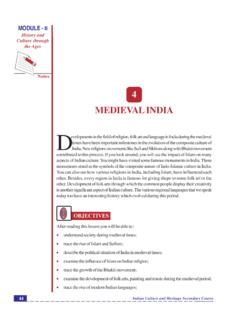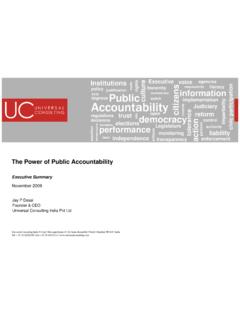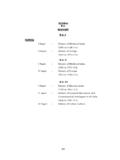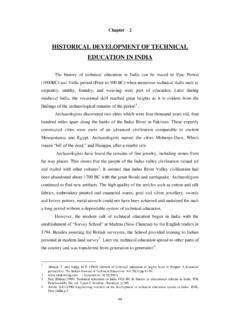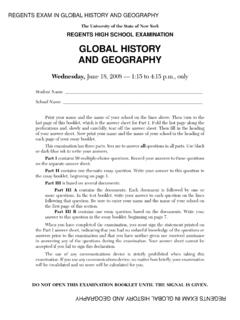Transcription of MEDIEVAL - Cultor
1 KHAN. india HISTORY. HISTORICAL DICTIONARIES OF ANCIENT. CIVILIZATIONS AND HISTORICAL ERAS, NO. 20 HISTORICAL. DICTIONARY OF. The MEDIEVAL period of Indian history is difficult to clearly define. It can be considered a long transition from ancient to precolonial times. Its end is marked by Vasco da Gama's voyage round the Cape of Good Hope in 1498 and the establishment of the . Mughal empire (1526). The renewed Islamic advance into north india , from roughly DICTIONARY OF. HISTORICAL. 1000 onward, leading to the rise of the Delhi Sultanate (1206), is the beginning of the MEDIEVAL period in political and cultural terms. For the purpose of the Historical Dictionary of MEDIEVAL india , the period from 1000 AD. MEDIEVAL india . to 1526 AD is considered india 's MEDIEVAL times. The turbulent history of this period is told through the book's chronology, introductory essay, bibliography, and hundreds of cross-referenced dictionary entries on key people, historical geography, the arts, institutions, events, and other important terms.
2 IQTIDAR ALAM KHAN retired as a professor of history from Aligarh Muslim University in Aligarh, india . He was the general president of the Indian History Congress'. 59th session held at Bangalore in 1997. MEDIEVAL .. india . For orders and information please contact the publisher IQTIDAR ALAM KHAN. Scarecrow Press, Inc.. A wholly owned subsidiary of The Rowman & Littlefield Publishing Group, Inc. Cover design by Neil D. Cotterill 4501 Forbes Boulevard, Suite 200. Lanham, Maryland 20706 ISBN-13: 978-0-8108-5503-8. ISBN-10: 0-8108-5503-8. 1-800-462-6420 fax 717-794-3803 90000. Cover photo: Dragon-Horse Carvings at Konarak Temple, india 9 780810 855038. Adam Woolfitt/CORBIS. 1 4/7/08 11:45:12 AM. 4/1/08 1:30 PM Page i HISTORICAL DICTIONARIES OF ANCIENT CIVILIZATIONS. AND HISTORICAL ERAS. Series editor: Jon Woronoff 1.
3 Ancient Egypt, Morris L. Bierbrier, 1999. 2. Ancient Mesoamerica, Joel W. Palka, 2000. 3. Pre-Colonial Africa, Robert O. Collins, 2001. 4. Byzantium, John H. Rosser, 2001. 5. MEDIEVAL Russia, Lawrence N. Langer, 2001. 6. Napoleonic Era, George F. Nafziger, 2001. 7. Ottoman Empire, Selcuk Aksin Somel, 2003. 8. Mongol World Empire, Paul D. Buell, 2003. 9. Mesopotamia, Gwendolyn Leick, 2003. 10. Ancient and MEDIEVAL Nubia, Richard A. Lobban Jr., 2003. 11. The Vikings, Katherine Holman, 2003. 12. The Renaissance, Charles G. Nauert, 2004. 13. Ancient Israel, Niels Peter Lemche, 2004. 14. The Hittites, Charles Burney, 2004. 15. Early North America, Cameron B. Wesson, 2005. 16. The Enlightenment, by Harvey Chisick, 2005. 17. Cultural Revolution, by Guo Jian, Yongyi Song, and Yuan Zhou, 2006. 18. Ancient Southeast Asia, by John N.
4 Miksic, 2007. 19. MEDIEVAL China, by Victor Cunrui Xiong, 2008. 20. MEDIEVAL india , by Iqtidar Alam Khan, 2008. 4/1/08 1:30 PM Page ii 4/1/08 1:30 PM Page iii Historical Dictionary of MEDIEVAL india Iqtidar Alam Khan Historical Dictionaries of Ancient Civilizations and Historical Eras, No. 20. The Scarecrow Press, Inc. Lanham, Maryland Toronto Plymouth, UK. 2008. 4/1/08 1:30 PM Page iv SCARECROW PRESS, INC. Published in the United States of America by Scarecrow Press, Inc. A wholly owned subsidiary of The Rowman & Littlefield Publishing Group, Inc. 4501 Forbes Boulevard, Suite 200, Lanham, Maryland 20706. Estover Road Plymouth PL6 7PY. United Kingdom Copyright 2008 by Iqtidar Alam Khan All rights reserved. No part of this publication may be reproduced, stored in a retrieval system, or transmitted in any form or by any means, electronic, mechanical, photocopying, recording, or otherwise, without the prior permission of the publisher.
5 British Library Cataloguing in Publication Information Available Library of Congress Cataloging-in-Publication Data Khan, Iqtidar Alam. Historical dictionary of MEDIEVAL india / Iqtidar Alam Khan. p. cm. (Historical dictionaries of ancient civilizations and historical eras ;. no. 20). Includes bibliographical references. ISBN-13: 978-0-8108-5503-8 (cloth : alk. paper). ISBN-10: 0-8108-5503-8 (cloth : alk. paper). 1. india History 1000 1526 Dictionaries. I. Title. 2008. dc22 2007046226. The paper used in this publication meets the minimum requirements of American National Standard for Information Sciences Permanence of Paper for Printed Library Materials, ANSI/NISO Manufactured in the United States of America. 4/1/08 1:30 PM Page v to Kamo who sustains me in the twilight of my life 4/1/08 1:30 PM Page vi 4/1/08 1:30 PM Page vii Contents Editor's Foreword ix Preface xi Note on Transliteration xiii Map xiv Chronology xv Introduction 1.
6 THE DICTIONARY 11. Bibliography 145. About the Author 169. vii 4/1/08 1:30 PM Page viii 4/1/08 3:09 PM Page ix Editor's Foreword The Historical Dictionary of MEDIEVAL india deals with a crucial form- ative period of what is already one of the world's biggest countries and, over recent decades, one that has added economic, political, and social clout to its size and numbers. So it is important to know india 's history, and this not only for Indians and others on the subcontinent but for all of us. Admittedly, this volume deals with an early period, namely and roughly the period between 1000 and 1526; however, this book is not just to inform us about what happened so many centuries ago but also to remind us of old sores that have not yet healed and old problems that will not readily go away. Indeed, more broadly, it helps us to put into context what some feel will be the greatest quandary and also con- flict of the 21st century: the reputed clash of civilizations.
7 What is happening today is not even as jarring as the clashes that took place in MEDIEVAL india , not so much among Indians (who did not exist yet) but among the many earlier kingdoms and states that would merge into In- dia, and even more decisively, between the Hindus, Buddhists, Mus- lims, and Christian West. This is an extremely tangled web, one that can only be untangled with considerable effort, and then only partially. So it is very helpful to have this handy guide, which while not following every last strand at least gives us a good look at many of the crucial details and an impres- sive overall view. This is done, first, in a chronology, without which it would be extremely difficult to follow events both over time and across the then-existing borders. The introduction extrapolates the main cur- rents and trends, and offers a comprehensible context.
8 But the most im- portant section is the dictionary, with a large number of entries on spe- cific persons, places and events, institutions and customs mainly political, but also social, religious, and cultural. The bibliography ix 4/1/08 3:09 PM Page x x EDITOR'S FOREWORD. comes at the end of the book, but should be the start of further studies for those who are interested. This volume was written by someone with exceptional credentials for the task. Iqtidar Alam Khan was a teacher of history at Aligarh Muslim University from 1957 to 1994, and also for some time chairman of the department and, later, dean. During his long career as a teacher, he has engaged in considerable research into different aspects of the MEDIEVAL Indian history as well as those of the Mughal Empire and most recently the application of gunpowder.
9 As a researcher, his career has been even longer; he published his latest book, Gunpowder and Firearms: Warfare in MEDIEVAL india , just a few years ago, and has since been working on the present historical dictionary. Thanks to his encyclopedic knowledge, his keen interest in the many subjects touched upon here, and an ability to sum up the overall situation and spell out the many details, he has provided a welcome introduction to a period that, as noted, is far more relevant than one may think. Jon Woronoff Series Editor 4/1/08 1:30 PM Page xi Preface For this historical dictionary, the themes for entries have been selected largely on the basis of the importance given to them in the major writ- ings on the period, from the pens of Mohammad Habib, Tara Chand, R. C. Majumdar, H. C. Ray, Ishwari Prasad, T.
10 Mahalingam, A. B. M. Habibullah, Romila Thapar, Haroon Khan Sherwani, Simon Digby, and Peter Jackson. Naturally, a balance had to be maintained between per- sons and institutions as well as between political, social, and religious aspects. Broadly, the treatment has been restricted to the MEDIEVAL pe- riod of Indian history (1000 1526) with a focus on the Delhi sultanate, 1206 1526, even when the regions concerned lay outside the limits of the Delhi sultanate. It remains for me to record my thanks: to the staff of the library of the Department of History, Aligarh Muslim University, for the help and courtesy extended to me throughout the preparation of this volume; to Faiz Habib for drawing a map; to Muneeruddin Khan for preparing the press copy; and to Shireen Moosvi, secretary, Aligarh Historians Soci- ety, for providing all possible facilities.



